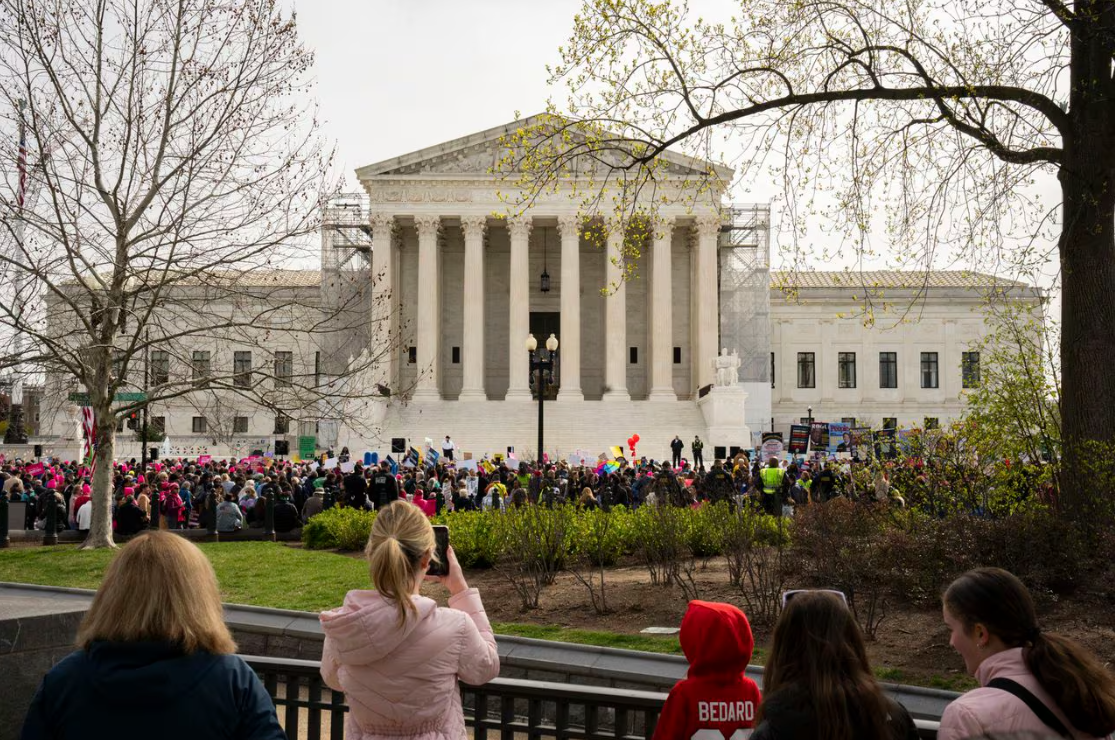最高法院似乎可能保留堕胎药物米非司酮的使用权

【中美创新时报2024 年 3 月 26 日讯】(记者温友平编译)周二(26日),最高法院似乎可能会保留一种药物的使用权,去年美国近三分之二的堕胎中都使用了这种药物,这是自两年前保守派法官推翻罗伊诉韦德案以来最高法院的第一起堕胎案件。美联社记者马克·谢尔曼(MARK SHERMAN)对此作了如下报道。
在近 90 分钟的争论中,似乎达成了共识,即质疑 FDA 批准米非司酮(mifepristone)药物以及随后为方便使用该药物而采取的行动的堕胎反对者缺乏提起诉讼的合法权利或地位。
这一决定将保留现行规则,允许患者通过邮寄方式收到药物,无需亲自去看医生,并在怀孕 10 周内服用药物进行堕胎。
拜登政府的最高法院首席律师、副检察长伊丽莎白·普雷洛加表示,法院应该明确表示,那些质疑 FDA 放宽米非司酮限制的反堕胎医生和组织距离拥有合法诉权利或资格“不到 100 英里”。
甚至三名支持推翻罗伊案的多数法官也对堕胎反对者的辩护律师提出了怀疑。艾米·科尼·巴雷特、尼尔·戈萨奇和布雷特·卡瓦诺大法官是前总统唐纳德·特朗普任命的三名最高法院法官。
例如,巴雷特似乎怀疑律师艾琳·霍利(Erin Hawley)指认的医生能否证明他们实际上受到 FDA 行为的伤害,这是证明地位的要求之一。
“对我来说,困难在于宣誓书读起来更像是良心反对,”巴雷特说。
堕胎反对者要求法官批准保守派联邦上诉法院的一项裁决,该裁决将限制米非司酮的使用,米非司酮是药物堕胎中使用的两种药物之一。
高等法院重返堕胎丛林之际,2022 年的堕胎决定重塑了政治和监管格局,导致许多共和党领导的州禁止或严格限制堕胎。
这项裁决立即产生了政治后果,预计夏初的新案件结果可能会影响国会和白宫的竞选。
周二早上,最高法院外的场面很热闹,示威者占领了法院周围的街道,双方的团体游行并高呼口号。警方还封锁了法院周围的交通。
对堕胎反对者的裁决的实际后果将是巨大的,可能会停止通过邮件和大型药房连锁店运送米非司酮,将怀孕期间可以使用米非司酮的时间从 10 周缩短到七周,并结束越来越受欢迎的可以开哪种药的远程医疗就诊。
乔·拜登总统的政府和药品制造商警告称,这样的结果还可能会邀请法官对该机构的科学判断进行事后质疑,从而更广泛地破坏 FDA 的药品审批程序。
反堕胎医生和医疗组织认为,FDA 在 2016 年和 2021 年放宽对该药物获取限制的决定是不合理的,并且“危及全国妇女的健康”。民主党政府和生产米非司酮的纽约丹科实验室回应称,该药物是 FDA 批准的最安全的药物之一。
在一项可能的解决方案中,法官们可以避免触及案件中更具政治敏感性的方面,同时保留米非司酮的使用权。政府和丹科认为挑战者缺乏起诉的合法权利或资格。如果高等法院同意,它基本上会驳回此案并取消上诉裁决。
另一起堕胎案已经提上日程。下个月,法官们将听取有关医院紧急治疗的联邦法律是否必须包括堕胎的争论,即使是在禁止堕胎的州也是如此。
米非司酮案在最高法院推翻罗伊诉韦德案五个月后开始审理。近一年前,堕胎反对者最初赢得了德克萨斯州特朗普提名人、美国地区法官马修·卡奇马里克(Matthew Kacsmaryk)的一项全面裁决,该裁决将完全撤销该药物的批准。美国第五巡回上诉法院维持 FDA 对米非司酮的初步批准不变。但这将扭转监管机构在 2016 年和 2021 年做出的改变,放宽了该药物的一些给药条件。
最高法院搁置了上诉法院修改后的裁决,然后同意审理此案,尽管推翻罗伊案的裁决的作者塞缪尔·阿利托法官和克拉伦斯·托马斯法官允许在案件审理过程中实施一些限制。
米非司酮是两种用于药物流产的药物之一,另一种是米索前列醇。他们的人数多年来一直在上升。自 2000 年以来,已有超过 600 万人使用米非司酮。米非司酮首先用于扩张子宫颈并阻断维持妊娠所需的孕酮激素。24至48小时后服用米索前列醇,使子宫收缩并排出妊娠组织。
医疗保健提供者表示,如果米非司酮不再可用或太难获得,他们将转而仅使用米索前列醇,米索前列醇在终止妊娠方面效果稍差。
题图:2024 年 3 月 26 日星期二上午,堕胎权利团体在华盛顿最高法院大楼外集会。MAANSI SRIVASTAVA/NYT
附原英文报道:
Supreme Court seems likely to preserve access to the abortion medication mifepristone
By MARK SHERMAN The Associated Press,Updated March 26, 2024,
WASHINGTON (AP) — The Supreme Court on Tuesday seemed likely to preserve access to a medication that was used in nearly two-thirds of all abortions in the U.S. last year, in the court’s first abortion case since conservative justices overturned Roe v. Wade two years ago.
In nearly 90 minutes of arguments, a consensus appeared to emerge that the abortion opponents who challenged the FDA’s approval of the medication, mifepristone, and subsequent actions to ease access to it lack the legal right, or standing, to sue.
Such a decision would leave the current rules in place that allow patients to receive the drug through the mail, without any need for an in-person visit with a doctor, and to take the medication to induce an abortion through 10 weeks of pregnancy.
Solicitor General Elizabeth Prelogar, the Biden administration’s top Supreme Court lawyer, said the court should make clear that the anti-abortion doctors and organizations that challenged the FDA’s relaxation of restrictions on mifepristone don’t “come within 100 miles” of having the legal right, or standing, to sue.
Even three justices who were in the majority to overturn Roe posed skeptical questions about standing to the lawyer for the abortion opponents. Justices Amy Coney Barrett, Neil Gorsuch and Brett Kavanaugh are former President Donald Trump’s three Supreme Court appointees.
Barrett, for example, seemed to doubt that the doctors identified by lawyer Erin Hawley could show that were actually harmed by the FDA’s actions, one of the requirements for showing standing.
“The difficulty, to me, is that the affidavits do read more like conscience objections,” Barrett said.
Abortion opponents are asking the justices to ratify a ruling from a conservative federal appeals court that would limit access to mifepristone, one of two drugs used in medication abortions.
The high court’s return to the abortion thicket is taking place in a political and regulatory landscape that was reshaped by the abortion decision in 2022 that led many Republican-led states to ban or severely restrict abortion.
That ruling had immediate political consequences, and the outcome in the new case, expected by early summer, could affect races for Congress and the White House.
The scene outside the Supreme Court was lively Tuesday morning, with demonstrators occupying the streets surrounding the court and groups on both sides of the issue marching and chanting. The police blocked traffic surrounding the court as well.
The practical consequences of a ruling for abortion opponents would be dramatic, possibly halting the delivery of mifepristone through the mail and at large pharmacy chains, reducing the period in pregnancy when it can be used from 10 to seven weeks and ending increasingly popular telehealth visits at which the drug can be prescribed.
President Joe Biden’s administration and drug manufacturers warn that such an outcome also could undermine the FDA’s drug approval process more widely by inviting judges to second-guess the agency’s scientific judgments.
Anti-abortion doctors and medical organizations argue that the FDA’s decisions in 2016 and 2021 to relax restrictions on getting the drug were unreasonable and “jeopardize women’s health across the nation.” The Democratic administration and New York-based Danco Laboratories, which makes mifepristone, respond that the drug is among the safest the FDA has ever approved.
In one possible resolution, the justices could avoid touching on the more politically sensitive aspects of the case while preserving access to mifepristone. The administration and Danco argue that the challengers lack the legal right, or standing, to sue. If the high court agrees, it would essentially dismiss the case and erase the appellate ruling.
An abortion-rights activist holds a box of mifepristone pills as demonstrators from both anti-abortion and abortion-rights groups rally outside the Supreme Court in Washington, Tuesday, March 26, 2024.
An abortion-rights activist holds a box of mifepristone pills as demonstrators from both anti-abortion and abortion-rights groups rally outside the Supreme Court in Washington, Tuesday, March 26, 2024.AMANDA ANDRADE-RHOADES/ASSOCIATED PRESS
Another abortion case already is on the docket. Next month, the justices will hear arguments over whether a federal law on emergency treatment at hospitals must include abortions, even in states that have otherwise banned them.
The mifepristone case began five months after the Supreme Court overturned Roe v. Wade. Abortion opponents initially won a sweeping ruling nearly a year ago from U.S. District Judge Matthew Kacsmaryk, a Trump nominee in Texas, which would have revoked the drug’s approval entirely. The 5th U.S. Circuit Court of Appeals left intact the FDA’s initial approval of mifepristone. But it would reverse changes regulators made in 2016 and 2021 that eased some conditions for administering the drug.
The Supreme Court put the appeals court’s modified ruling on hold, then agreed to hear the case, though Justices Samuel Alito, the author of the decision overturning Roe, and Clarence Thomas would have allowed some restrictions to take effect while the case proceeded.
Mifepristone is one of two drugs, along with misoprostol, used in medication abortions. Their numbers have been rising for years. More than 6 million people have used mifepristone since 2000. Mifepristone is taken first to dilate the cervix and block the hormone progesterone, which is needed to sustain a pregnancy. Misoprostol is taken 24 to 48 hours later, causing the uterus to contract and expel pregnancy tissue.
Health care providers have said that if mifepristone is no longer available or is too hard to obtain, they would switch to using only misoprostol, which is somewhat less effective in ending pregnancies.

